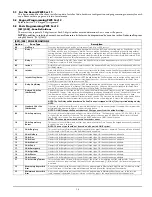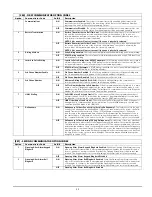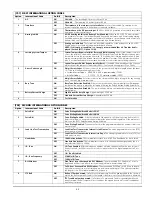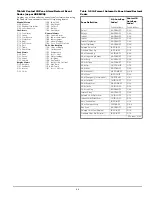
32
SIA (Level 2)
SIA is a specialized format that will communicate infor-
mation quickly using frequency shift keying (FSK) rather
than pulses. The SIA format will automatically generate
the type of signal being transmitted, such as Burglary,
Fire, Panic etc. The two digit reporting code is used to
identify the zone or access code number.
NOTE:
SIA format must be used for phone numbers pro-
grammed to communicate via the T-Link.
If the SIA format is selected the panel can be programmed
to automatically generate all zone and access code num-
bers eliminating the need to program these items.
If the SIA Sends Automatic Reporting Codes
SIA Sends Automatic Reporting Codes
SIA Sends Automatic Reporting Codes
SIA Sends Automatic Reporting Codes option is
enabled the panel will operate as follows:
1. If the reporting code for an event is programmed as
[00] the panel will not attempt to call the central sta-
tion.
2. If the reporting code for an event is programmed as
anything from [01] to [FF] the panel will AUTOMATI-
CALLY generate the zone or access code number.
3. Bypassed zones will always be identified when partial
closing of the system occurs.
The Communicator Call Direction Options can be used to
disable reporting of events such as Openings/Closings.
Also, if all the Opening/Closing reporting codes were
programmed as [00] the panel would not report.
If the SIA Sends Automatic Reporting Codes
SIA Sends Automatic Reporting Codes
SIA Sends Automatic Reporting Codes
SIA Sends Automatic Reporting Codes option is
disabled the panel will operate as follows:
1. If the reporting code for an event is programmed as [00]
or [FF] the panel will not attempt to call the central sta-
tion.
2. If the reporting code for an event is programmed as any-
thing from [01] to [FE] the panel will send the pro-
grammed reporting code.
3. Bypassed zones will not be identified when partial clos-
ing the system.
NOTE:
The zone number for Zone Low Battery and Zone
Fault events will not be identified when Programmed SIA is
used.
SIA Sends Automatic Reporting Codes . . . Section [381], Option [3]
Communicator Call Direction Options. . . . . . Section [351] to [376]
SIA Identifiers . . . . . . . . . . . . . . . . . . . . . . . . . . . . . . . .Appendix A
Residential Dial
If Residential Dial is programmed and an event pro-
grammed to communicate occurs, the panel will seize the
line and dial the appropriate telephone number(s). Once
the dialing is complete, the panel will emit an ID tone and
wait for a handshake (press a 1, 2, 4, 5, 7, 8, 0,
✱
or # key
from any telephone). It will wait for this handshake for
the duration of Post Dial Wait for Handshake
Post Dial Wait for Handshake
Post Dial Wait for Handshake
Post Dial Wait for Handshake timer. Once
the panel receives the handshake, it will emit an alarm
tone over the telephone line for 20 seconds. If several
alarms occur at the same time, only one call will be made
to each telephone number the panel is programmed to
call.
NOTE:
The Residential Dial format will not work over the
LINKS1000.
Communicator Call Direction Options. . . . . . Section [351] to [376]
Pager Format
The Communicator Format
Communicator Format
Communicator Format
Communicator Format option for either telephone
number can be programmed for Pager format. If an event
occurs and the Communicator Call Direction
Communicator Call Direction
Communicator Call Direction
Communicator Call Direction options
direct the call to a telephone number with the Pager for-
mat selected the panel will attempt to page.
When calling a pager extra digits will be required to make
it work properly.The following is a list of Hex digits and
the function they perform:
Hex [A] - not used
Hex [B] - simulates the [
✱
] key on a tone telephone
Hex [E] - two second pause
Hex [C] - simulates the [#] key on a tone telephone
Hex [F] - end of telephone number marker
Hex [D] - forces the panel to search for dial tone
The panel will attempt to call the pager one time. After
dialing the digits in the telephone number the panel will
send the account number and reporting code followed by
the [#] key (Hex [C]).
There is no ringback when using Pager format. The panel
has no way of confirming if the pager was called success-
fully; a Failure to Communicate Trouble will only be gen-
erated once the maximum number of attempts has been
reached.
NOTE:
The Pager format cannot be used with the
LINKS1000 cellular communicator.
NOTE:
Do not use the digit C in a reporting code when
using Pager format. In most cases, the digit C will be inter-
preted as a [#], which will terminate the page before it has
finished.
NOTE:
If the panel detects a busy signal, it will attempt to
page again. It will make the maximum number of attempts
programmed in section [165]. Force dialing should be dis-
abled when using Pager format.
NOTE:
When using Pager format, you must program two
hex digit Es at the end of the telephone number.
Pulse Formats
Depending on the pulse format selected the panel will
communicate using the following:
• 3/1, 3/2, 4/1 or 4/2
• 1400 or 2300 Hz handshake
• 10 or 20 bits per second
• non-extended
The digit ‘0’ will send no pulses and is used as a filler.
When programming account numbers enter four digits.
When programming a 3-digit account number the fourth
digit must be programmed as a plain ‘0’ which will act as
a filler digit.
If an account number has a ‘0’ in it, substitute a Hex digit
‘A’ for the ‘0’. Examples:
• 3-digit account number [123]- program [1230]
• 3-digit account number [502] - program [5A20]
• 4-digit account number [4079] - program [4A79]
When programming reporting codes two digits must be
entered. If one digit reporting codes are to be used the sec-
ond digit must be programmed as a ‘0’. If a ‘0’ is to be
transmitted substitute a Hex digit ‘A’ for the ‘0’. Examples:
• 1-digit reporting code [3] - program [30]
• 2-digit reporting code [30] - program [3A]
To prevent the panel from reporting an event program the
reporting code for the event as [00] or [FF].
Contact ID
Contact ID is a specialized format that will communicate
information quickly using tones rather than pulses. In
addition to sending information more quickly the format
also allows more information to be sent. For example,
rather than reporting an alarm zone 1 the Contact ID for-
mat can also report the type of alarm, such as Entry/Exit
alarm zone 1.
Summary of Contents for PC1555 CP-01
Page 2: ...NOTES...
Page 6: ...v PC1555 CP 01 Wiring Diagram NOTE Remove CON1 when using PGM2 for 2 wire smoke...
Page 55: ...NOTES...
















































